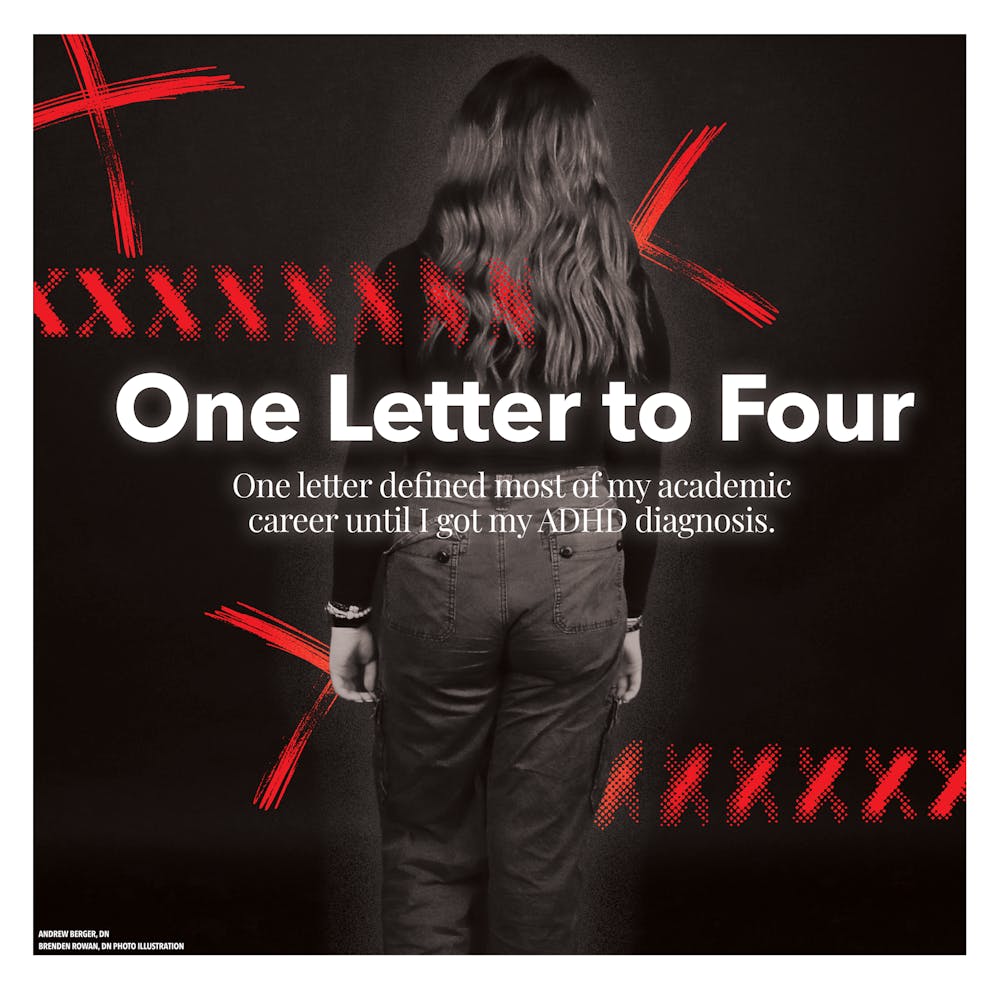Payton Hammett is a first-year journalism major and writes “Payton’s Pen” for the Daily News. Their views do not necessarily reflect those of the newspaper.
Growing up, I felt defined by one letter: X.
This X haunted my childhood. It was one of the 26 letters teachers could put in their comment box on our report cards. Somehow, with only a 3.8 percent chance of getting this X, I got it every year.
What does it mean? “Talks excessively.”
I never felt I talked too much, and I never knew why it was a concern for my educators. I simply enjoyed having friends and talking to them.
I felt so frustrated and confused. I didn’t understand why boys, who talked just as much as me had their actions written off with the phrase, “Oh, it's just Attention Deficit Hyperactivity Disorder (ADHD)!” beeded
But when I talked too much, I was sent to the hallway, called annoying and got an X on my report card. I spent most of my time in the hallway thinking about whether those boys got an X on their report cards too.
My breaking point came when I got a report card with not one X but two. This triggered some sort of switch in my prepubescent brain.
It was then that I started to think that something was wrong with me.
So, I tried to talk less. This lasted for maybe a day or two, but it didn’t work. No matter what I did, I couldn’t limit my verbal communication. I don’t think I have ever been more angry and frustrated with myself in my entire life.
This anger started to seep into every part of my life.
I was angry in class. No matter how much I paid attention, nothing would stick. I heard the content, but I couldn’t understand it.
Imagine the content being taught to me as a handful of 10 pencils. I heard the content in my right ear, but 9 out of the 10 pencils came out of my left ear. I only actually internalized 10 percent of what I was being taught.
I was so angry all the time that I would break down after school. I would be so angry that I was crying and I would cry even more.
I would go from 0-100 in seconds — there was no in-between. I felt every single emotion so intensely. Whether something life-changing happened, or I lost my favorite pen, I would cry. I was always in the school bathroom crying, texting my mom, begging for her to come pick me up.
After the COVID-19 pandemic, I was diagnosed with anxiety.
I loved volleyball with my entire heart and was so excited to play in high school, but when the time came, I couldn’t do it. The first practice I went to, I had to leave because of a panic attack. So, not only was I always angry, I was always anxious. It wasn’t a good mix.
I barely went to school my freshman year because of my anxiety and, looking back on it, my paralyzing anger. Going to school felt like an impossible mountain to climb. I was terrified of getting an X on my report card, terrified of crying in class because I couldn’t control it and terrified to sit in class feeling helpless because I could not understand what my teacher was saying.
I was terrified of failing. My excessive talking — and crying — made it hard to make friends. I would get called annoying and dramatic. Nobody wanted to be friends with the girl who talked all the time and cried even more.
Usually, it would be easier to conquer this seemingly insurmountable climb that I called school with friends, but I didn’t really have many. Rather, I didn’t have any friends who understood me. But I didn’t understand me either.
By my sophomore year, I was exhausted. I thought I was broken and the only explanation seemed to be the X on my report card. But this wasn’t enough for me. One letter was not enough.
I needed a solution.
I needed an answer to my problem because an X didn’t explain why it was so hard to make friends, an X didn’t explain why I would cry all the time, an X didn’t explain why I didn’t understand my teachers, an X didn’t explain why I was so anxious. This X didn’t explain why I talked so much, it simply identified it.
I didn’t need any more identification, I needed to know why.
I did what everyone does when they need an answer, and I googled it: “Why do I talk so much?” The first result: ADHD. I was initially confused because, to me, ADHD was the boys in my elementary school class who couldn’t sit still.
I thought that maybe it was ADHD, but nobody around me seemed to agree. They wouldn’t hear me. I felt broken, exhausted and unheard.
I didn’t fit the ADHD stereotype, but they only saw one side of my symptoms and took it upon themselves to create an explanation.
Although I never understood what my teachers were saying, I still got all of my work done because I was a crippling perfectionist. Everybody else's explanation for my excessive talking was merely my “outgoing personality.” My crying all the time was just me being “dramatic.”
All of these explanations were sufficient for everyone else, but they were not sufficient for me. I continued doing research, and the pieces started to fall into place. I started being more persistent, and finally, people listened to me.
I was finally diagnosed with ADHD the summer before my high school junior year. An X no longer defined me. Instead, I felt explained by four letters: A, D, H and D.
According to the CDC, 6 million children between the ages of 2 and 17 have been diagnosed with ADHD. However, a 2024 study from the Clevland Health Clinic shows that girls are 16 times less likely than boys to be diagnosed and treated for ADHD.
ADHD has two subtypes: inattentive and hyperactive-impulsive. Boys often fall under the hyperactive-impulsive subtype, which is more identifiable from the outside. Girls oftentimes fall under the inattentive subtype where symptoms are often internalized and unnoticeable from the outside.
According to the Journal of Clinical Child & Adolescent Psychology, ADHD is frequently identified in classrooms, where boys are more likely to get referrals for a diagnosis because their symptoms are undeniable — overt aggression, restlessness, fidgeting and impulsivity. For girls, ADHD is not worn on our sleeves. It is less likely to be noticed by teachers because the inattentive type is not disruptive.
Teachers cannot see the low self-esteem, emotional dysregulation, impulsive/risky behaviors and difficulty in making friends.
Undiagnosed ADHD often results in the development of perfectionistic behaviors, so schoolwork is still accomplished. Speaking of perfectionist behaviors, this crippling perfectionism often results in coping mechanisms and masking of their symptoms.
Girls may be mistakenly diagnosed with anxiety and/or depression because of the overlap in symptoms, or these mental illnesses may develop due to the lack of diagnosis. This in turn decreases the likelihood of an ADHD diagnosis altogether. Regardless, these symptoms only become more severe the longer they go undiagnosed.
Many girls, including myself, are left feeling like they are broken — a feeling so heavy that it is indescribable. These feelings of brokenness due to a lack of diagnoses can start to transform into not only low self-esteem but also anxiety and depression.
It is crucial to diagnose ADHD in girls and diagnose it early. No person should ever be left crying to whoever will listen, begging to be “fixed.” I did not need to be fixed — nothing was “wrong” with me. I just needed the proper diagnosis and proper treatment.
The under diagnosis of ADHD needs to be fixed.
Educating people about the differences in ADHD between girls and boys is crucial because most referrals happen in the classroom; teachers must be educated and know how to identify all forms of ADHD.
Parents play an even bigger role. Life with ADHD is hard, but life without a diagnosis is even harder. Parents need to listen to their children when they express concern and pay attention to their kid’s behavior or changes in their behavior. Parents need to be proactive for their children to fight for a referral or for a diagnosis and need to advocate for their kids.
ADHD has become a weightless term in day-to-day life. ADHD is not just nonstop talking and fidgeting; it is a disorder that adds extra weight to every single part of life.
Do not let ADHD become a slogan for being hyper.
Sometimes, I still feel like an imposter. The years I lived without a diagnosis left me in denial and left me feeling unheard. If there is one thing you choose to do, do not just hear girls’ experiences with ADHD, but listen to them and validate them.
We cannot keep letting young girls feel broken. It’s vital to know the differences between hyperactive-impulsive and inattentive, validate concerns, diagnose early, provide treatment and listen.
Contact Payton Hammet via email at payton.hammett@bsu.edu.





The Daily News welcomes thoughtful discussion on all of our stories, but please keep comments civil and on-topic. Read our full guidelines here.